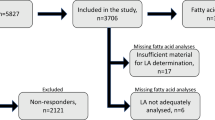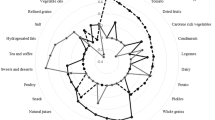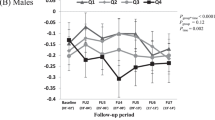Abstract
Background: Prevention of coronary heart disease (CHD) in high-risk subjects.
Objective: To investigate the associations of dietary intake of alpha-linolenic acid (ALA) and linoleic acid (LA) as assessed by food frequency questionnaire and in the plasma cholesteryl ester (CE), with CHD risk factors.
Design: Baseline data of a double-blind, randomized placebo-controlled trial. Subjects have hypercholesterolemia (6.0–8.0 mmol/l) and at least two other CHD risk factors (n=266).
Results: The reported dietary ALA and LA intakes and the LA/ALA ratio were associated with the contents in the CE (r=0.37, r=0.21, and r=0.42, respectively; P<0.01). In multivariate analysis, CE ALA was inversely associated with diastolic blood pressure (r=−0.13; P<0.05) and positively with serum triacylglycerol (r=0.13; P<0.05), and CE LA was inversely associated with serum triacylglycerol (r=−0.32; P<0.01). The CE LA/ALA ratio was strongly inversely associated with CE ALA (r=−0.95; P<0.01). In the lowest quintile of CE ALA, mean dietary intake was 0.4 energy % ALA (1.2 g/day), 8.4 energy % LA and an LA/ALA ratio of 21, and in the highest quintile 0.6 energy % ALA (1.7 g/day), 6.8 energy % LA and 12 (ratio). In the lowest quintile of CE ALA the diastolic blood pressure was 4 mmHg lower (P trend<0.05), and the serum triacylglycerol 0.3 mmol/l higher (P trend NS) when compared with the top quintile.
Conclusions: In a CHD high-risk population with LA-rich background diet, these cross-sectional data suggest that replacing LA in the diet by ALA may decrease diastolic blood pressure, and may increase serum triacylglycerol concentration.
Sponsorship: Dutch Prevent fund grant no. 28-2757; Unilever (margarine).
European Journal of Clinical Nutrition (2000) 54, 865–871
This is a preview of subscription content, access via your institution
Access options
Subscribe to this journal
Receive 12 print issues and online access
$259.00 per year
only $21.58 per issue
Buy this article
- Purchase on Springer Link
- Instant access to full article PDF
Prices may be subject to local taxes which are calculated during checkout
Similar content being viewed by others
Author information
Authors and Affiliations
Contributions
Guarantor: B Meyboom-de Jong.
Contributors: All authors have contributed to the execution, interpretation and reporting of the study.
Corresponding author
Rights and permissions
About this article
Cite this article
Bemelmans, W., Muskiet, F., Feskens, E. et al. Associations of alpha-linolenic acid and linoleic acid with risk factors for coronary heart disease. Eur J Clin Nutr 54, 865–871 (2000). https://doi.org/10.1038/sj.ejcn.1601102
Received:
Revised:
Accepted:
Published:
Issue Date:
DOI: https://doi.org/10.1038/sj.ejcn.1601102
Keywords
This article is cited by
-
Menhaden oil, but not safflower or soybean oil, aids in restoring the polyunsaturated fatty acid profile in the novel delta-6-desaturase null mouse
Lipids in Health and Disease (2012)
-
Dietary supplementation with flaxseed oil lowers blood pressure in dyslipidaemic patients
European Journal of Clinical Nutrition (2007)
-
Increased α-linolenic acid intake lowers C-reactive protein, but has no effect on markers of atherosclerosis
European Journal of Clinical Nutrition (2004)



